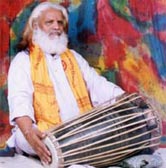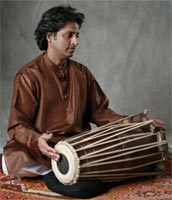PAKHAWAJ
History
The Pakhawaj in India is also called Mardal, Pakhawaj, Pakuaj, Pakhvaj, Pakavaj or Mardala, as it is a barrel-shaped, two-headed drum. The Indian Pakhawaj is a standard percussion instrument in the dhrupad style and is widely used and with accompaniment for various forms of music and dance performances.The pakhavaj has a low, mellow tone and is very rich in harmonics. Player should sit horizontally on a cushion in front of the drummer's crossed leg, the larger bass-skin is played with the left hand, the treble skin by the right hand.
The bass face is smeared with wet wheat dough which acts as the kiran and is the cause of the vivid, bass sound the Pakhawaj produces. This makes it very traditional in its built and rich in sound.
Brief Introduction

There are many styles of pakhawaj playing. The most well known is the accompaniment of dhrupad and dhammar singers and the instrument is also very much used for Orissi dancers and occasionally for kathak. It is also found in a classical form from Rajasthan known as Haveli Sangeet. Pakhawaj's compositions are passed down from generation to generation. Unlike the tabla, they are taught by a series of mnemonic syllables known as bol. There are major differences between the tabla bols and the pakhawaj bols. These are usually confusing to musicians who wish to play pakhawaj compositions on the tabla.
Ball of dough from aata,(atta is wheat ground into powder form) is appled to the bass skin for tuning the Pakhwaj. And by adjusting the strings there are different ragas coming up which is normally seen with various other drums. The fundamental tone of the pakhawaj will always be the lower tonic. Traditionally, the Pakhawaj remains the most favored percussion instrument during high level performances of the Dhrupad-style, whether it is vocal, on Rudra-Veena or on Surbahar.
Popular Musicians

- Ayodhya Prasad
- Taranath Rao
- Manik Munde
- Chatrapati Singh
- Arjun Shejwal
- Ramji Upadhyay
- Mohan Shyam Sharma
How to play a Pakhawaj
The playing position is easy as for the right-handed person, the smaller end is placed on the right hand and the larger side is placed on the left side. The right side is often raised slightly by placing a small rolled up piece of cloth under it. The person playing the instrument should sit horizontally on a cushion in front of a crossed-leg and then the larger bass-skin is played with the left hand, the treble skin by the right hand. The membranes are looped with leather thongs around the hollowed barrel, which is widest in the middle. Eight pieces of such two inch wooden roundstock are pried between thongs and barrel and are hammered tight. Then later treble skin is fitted with three concentric rings of dense black hardened paste which helps create a sound resonant with harmonics.The treble skin is tuned with a tuning-hammer of the instrument, holding the instrument in a vertical position, striking down along the rim over the barrel to raise the pitch, turning it on its vertical axis as it is tuned all along the circumference of the skin. The sound emitted by a particular stroke should merge well with that of the accompanying tanpura. The bass skin is tuned not by adjusting the tension but by applying a ball of dough from atrta, whole-fiber wheat. Its fundamental tone will be the lower tonic. Traditionally, the pakhavaj has been the most popular instrument for performances of the Dhrupad-style, be it vocal, on Rudra-Veena or on Surbahar. These are all capable of employing low registers so the colours match well.
Where to learn to play a Pakhawaj
TARANG School for Classical Indian Dance and MusicManager: Marie-Luise Siebenkaes
Johannisstrasse 14D-90763 Fuerth
Germany Telephone: +49-(0)911-6708040
Fax: +49 (0)1212-512616701 USt-IdNr.: DE228189973
Guru Harekrushna Behera college of arts and culture
Sri Kamalakanta Biswal,
At-Bhaskarganj 'A' P.o.- /Dist.- Balasore.
Regd. no.-BLS/6388/5 Phone-06782-260426
Mobile-9437160014 E-mail- [email protected]
Where to buy a Pakhawaj
Raj Musicals2188/6 main road west Patel nagar,
Opp. metro rail pillar no. 224,
New Delhi-110008, INDIA
Tel. (Shop) : +91 11 25700413, +91 11 65492392
Tel. (Res.) : +91 11 25393877
(Mob) : +91 9810230320 (S. Raj), +91 9899272572 (Sanjeev)
By Email : [email protected] [email protected]
Chopra Musicals
Address: 43, B. I. Lines, Madhya Path, Meerut, Uttar Pradesh - 250 001, India
Phone: +(91)-(121)-2647058/3250121/2530962
Fax: +(91)-(121)-647563
Sathyadeep Musical Palace
Mr Ashish Shrivastava
Beside Vysya Bank
Post- Puttaparthy
Dist-- Anantapur
Andhra Pradesh Pin- 515134
INDIA
[email protected]
[email protected]


